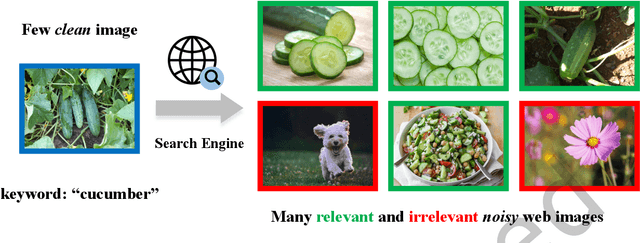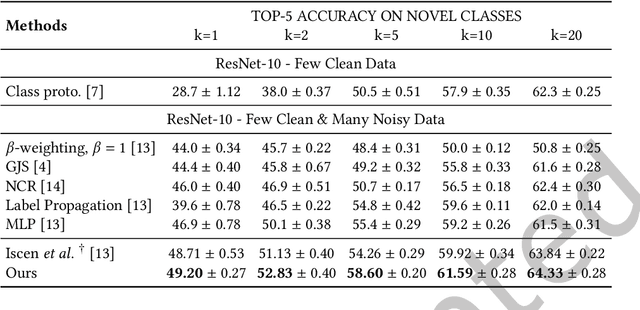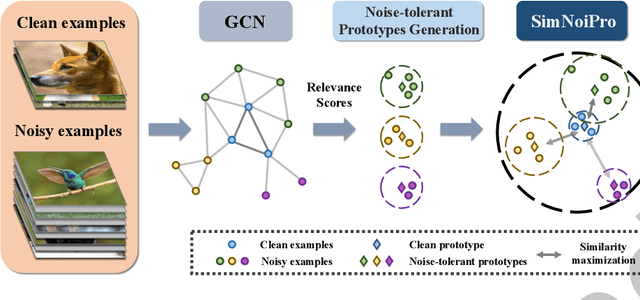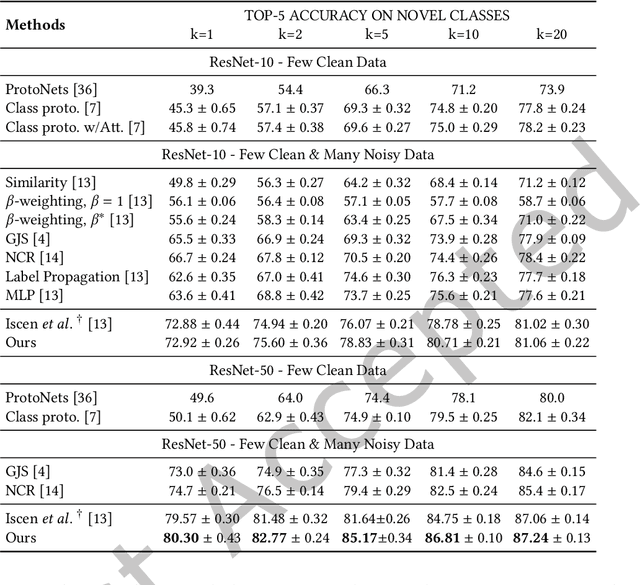Zongxin Yang
SurgBench: A Unified Large-Scale Benchmark for Surgical Video Analysis
Jun 09, 2025Abstract:Surgical video understanding is pivotal for enabling automated intraoperative decision-making, skill assessment, and postoperative quality improvement. However, progress in developing surgical video foundation models (FMs) remains hindered by the scarcity of large-scale, diverse datasets for pretraining and systematic evaluation. In this paper, we introduce \textbf{SurgBench}, a unified surgical video benchmarking framework comprising a pretraining dataset, \textbf{SurgBench-P}, and an evaluation benchmark, \textbf{SurgBench-E}. SurgBench offers extensive coverage of diverse surgical scenarios, with SurgBench-P encompassing 53 million frames across 22 surgical procedures and 11 specialties, and SurgBench-E providing robust evaluation across six categories (phase classification, camera motion, tool recognition, disease diagnosis, action classification, and organ detection) spanning 72 fine-grained tasks. Extensive experiments reveal that existing video FMs struggle to generalize across varied surgical video analysis tasks, whereas pretraining on SurgBench-P yields substantial performance improvements and superior cross-domain generalization to unseen procedures and modalities. Our dataset and code are available upon request.
In-Context Edit: Enabling Instructional Image Editing with In-Context Generation in Large Scale Diffusion Transformer
Apr 29, 2025Abstract:Instruction-based image editing enables robust image modification via natural language prompts, yet current methods face a precision-efficiency tradeoff. Fine-tuning methods demand significant computational resources and large datasets, while training-free techniques struggle with instruction comprehension and edit quality. We resolve this dilemma by leveraging large-scale Diffusion Transformer (DiT)' enhanced generation capacity and native contextual awareness. Our solution introduces three contributions: (1) an in-context editing framework for zero-shot instruction compliance using in-context prompting, avoiding structural changes; (2) a LoRA-MoE hybrid tuning strategy that enhances flexibility with efficient adaptation and dynamic expert routing, without extensive retraining; and (3) an early filter inference-time scaling method using vision-language models (VLMs) to select better initial noise early, improving edit quality. Extensive evaluations demonstrate our method's superiority: it outperforms state-of-the-art approaches while requiring only 0.5% training data and 1% trainable parameters compared to conventional baselines. This work establishes a new paradigm that enables high-precision yet efficient instruction-guided editing. Codes and demos can be found in https://river-zhang.github.io/ICEdit-gh-pages/.
MedSAM2: Segment Anything in 3D Medical Images and Videos
Apr 04, 2025Abstract:Medical image and video segmentation is a critical task for precision medicine, which has witnessed considerable progress in developing task or modality-specific and generalist models for 2D images. However, there have been limited studies on building general-purpose models for 3D images and videos with comprehensive user studies. Here, we present MedSAM2, a promptable segmentation foundation model for 3D image and video segmentation. The model is developed by fine-tuning the Segment Anything Model 2 on a large medical dataset with over 455,000 3D image-mask pairs and 76,000 frames, outperforming previous models across a wide range of organs, lesions, and imaging modalities. Furthermore, we implement a human-in-the-loop pipeline to facilitate the creation of large-scale datasets resulting in, to the best of our knowledge, the most extensive user study to date, involving the annotation of 5,000 CT lesions, 3,984 liver MRI lesions, and 251,550 echocardiogram video frames, demonstrating that MedSAM2 can reduce manual costs by more than 85%. MedSAM2 is also integrated into widely used platforms with user-friendly interfaces for local and cloud deployment, making it a practical tool for supporting efficient, scalable, and high-quality segmentation in both research and healthcare environments.
DreamRenderer: Taming Multi-Instance Attribute Control in Large-Scale Text-to-Image Models
Mar 17, 2025Abstract:Image-conditioned generation methods, such as depth- and canny-conditioned approaches, have demonstrated remarkable abilities for precise image synthesis. However, existing models still struggle to accurately control the content of multiple instances (or regions). Even state-of-the-art models like FLUX and 3DIS face challenges, such as attribute leakage between instances, which limits user control. To address these issues, we introduce DreamRenderer, a training-free approach built upon the FLUX model. DreamRenderer enables users to control the content of each instance via bounding boxes or masks, while ensuring overall visual harmony. We propose two key innovations: 1) Bridge Image Tokens for Hard Text Attribute Binding, which uses replicated image tokens as bridge tokens to ensure that T5 text embeddings, pre-trained solely on text data, bind the correct visual attributes for each instance during Joint Attention; 2) Hard Image Attribute Binding applied only to vital layers. Through our analysis of FLUX, we identify the critical layers responsible for instance attribute rendering and apply Hard Image Attribute Binding only in these layers, using soft binding in the others. This approach ensures precise control while preserving image quality. Evaluations on the COCO-POS and COCO-MIG benchmarks demonstrate that DreamRenderer improves the Image Success Ratio by 17.7% over FLUX and enhances the performance of layout-to-image models like GLIGEN and 3DIS by up to 26.8%. Project Page: https://limuloo.github.io/DreamRenderer/.
X-Field: A Physically Grounded Representation for 3D X-ray Reconstruction
Mar 11, 2025Abstract:X-ray imaging is indispensable in medical diagnostics, yet its use is tightly regulated due to potential health risks. To mitigate radiation exposure, recent research focuses on generating novel views from sparse inputs and reconstructing Computed Tomography (CT) volumes, borrowing representations from the 3D reconstruction area. However, these representations originally target visible light imaging that emphasizes reflection and scattering effects, while neglecting penetration and attenuation properties of X-ray imaging. In this paper, we introduce X-Field, the first 3D representation specifically designed for X-ray imaging, rooted in the energy absorption rates across different materials. To accurately model diverse materials within internal structures, we employ 3D ellipsoids with distinct attenuation coefficients. To estimate each material's energy absorption of X-rays, we devise an efficient path partitioning algorithm accounting for complex ellipsoid intersections. We further propose hybrid progressive initialization to refine the geometric accuracy of X-Filed and incorporate material-based optimization to enhance model fitting along material boundaries. Experiments show that X-Field achieves superior visual fidelity on both real-world human organ and synthetic object datasets, outperforming state-of-the-art methods in X-ray Novel View Synthesis and CT Reconstruction.
The Devil is in Temporal Token: High Quality Video Reasoning Segmentation
Jan 15, 2025



Abstract:Existing methods for Video Reasoning Segmentation rely heavily on a single special token to represent the object in the keyframe or the entire video, inadequately capturing spatial complexity and inter-frame motion. To overcome these challenges, we propose VRS-HQ, an end-to-end video reasoning segmentation approach that leverages Multimodal Large Language Models (MLLMs) to inject rich spatiotemporal features into hierarchical tokens.Our key innovations include a Temporal Dynamic Aggregation (TDA) and a Token-driven Keyframe Selection (TKS). Specifically, we design frame-level <SEG> and temporal-level <TAK> tokens that utilize MLLM's autoregressive learning to effectively capture both local and global information. Subsequently, we apply a similarity-based weighted fusion and frame selection strategy, then utilize SAM2 to perform keyframe segmentation and propagation. To enhance keyframe localization accuracy, the TKS filters keyframes based on SAM2's occlusion scores during inference. VRS-HQ achieves state-of-the-art performance on ReVOS, surpassing VISA by 5.9%/12.5%/9.1% in J&F scores across the three subsets. These results highlight the strong temporal reasoning and segmentation capabilities of our method. Code and model weights will be released at VRS-HQ.
3DIS-FLUX: simple and efficient multi-instance generation with DiT rendering
Jan 09, 2025Abstract:The growing demand for controllable outputs in text-to-image generation has driven significant advancements in multi-instance generation (MIG), enabling users to define both instance layouts and attributes. Currently, the state-of-the-art methods in MIG are primarily adapter-based. However, these methods necessitate retraining a new adapter each time a more advanced model is released, resulting in significant resource consumption. A methodology named Depth-Driven Decoupled Instance Synthesis (3DIS) has been introduced, which decouples MIG into two distinct phases: 1) depth-based scene construction and 2) detail rendering with widely pre-trained depth control models. The 3DIS method requires adapter training solely during the scene construction phase, while enabling various models to perform training-free detail rendering. Initially, 3DIS focused on rendering techniques utilizing U-Net architectures such as SD1.5, SD2, and SDXL, without exploring the potential of recent DiT-based models like FLUX. In this paper, we present 3DIS-FLUX, an extension of the 3DIS framework that integrates the FLUX model for enhanced rendering capabilities. Specifically, we employ the FLUX.1-Depth-dev model for depth map controlled image generation and introduce a detail renderer that manipulates the Attention Mask in FLUX's Joint Attention mechanism based on layout information. This approach allows for the precise rendering of fine-grained attributes of each instance. Our experimental results indicate that 3DIS-FLUX, leveraging the FLUX model, outperforms the original 3DIS method, which utilized SD2 and SDXL, and surpasses current state-of-the-art adapter-based methods in terms of both performance and image quality. Project Page: https://limuloo.github.io/3DIS/.
Noise-Tolerant Hybrid Prototypical Learning with Noisy Web Data
Jan 05, 2025



Abstract:We focus on the challenging problem of learning an unbiased classifier from a large number of potentially relevant but noisily labeled web images given only a few clean labeled images. This problem is particularly practical because it reduces the expensive annotation costs by utilizing freely accessible web images with noisy labels. Typically, prototypes are representative images or features used to classify or identify other images. However, in the few clean and many noisy scenarios, the class prototype can be severely biased due to the presence of irrelevant noisy images. The resulting prototypes are less compact and discriminative, as previous methods do not take into account the diverse range of images in the noisy web image collections. On the other hand, the relation modeling between noisy and clean images is not learned for the class prototype generation in an end-to-end manner, which results in a suboptimal class prototype. In this article, we introduce a similarity maximization loss named SimNoiPro. Our SimNoiPro first generates noise-tolerant hybrid prototypes composed of clean and noise-tolerant prototypes and then pulls them closer to each other. Our approach considers the diversity of noisy images by explicit division and overcomes the optimization discrepancy issue. This enables better relation modeling between clean and noisy images and helps extract judicious information from the noisy image set. The evaluation results on two extended few-shot classification benchmarks confirm that our SimNoiPro outperforms prior methods in measuring image relations and cleaning noisy data.
Generalizable Origin Identification for Text-Guided Image-to-Image Diffusion Models
Jan 04, 2025
Abstract:Text-guided image-to-image diffusion models excel in translating images based on textual prompts, allowing for precise and creative visual modifications. However, such a powerful technique can be misused for spreading misinformation, infringing on copyrights, and evading content tracing. This motivates us to introduce the task of origin IDentification for text-guided Image-to-image Diffusion models (ID$^2$), aiming to retrieve the original image of a given translated query. A straightforward solution to ID$^2$ involves training a specialized deep embedding model to extract and compare features from both query and reference images. However, due to visual discrepancy across generations produced by different diffusion models, this similarity-based approach fails when training on images from one model and testing on those from another, limiting its effectiveness in real-world applications. To solve this challenge of the proposed ID$^2$ task, we contribute the first dataset and a theoretically guaranteed method, both emphasizing generalizability. The curated dataset, OriPID, contains abundant Origins and guided Prompts, which can be used to train and test potential IDentification models across various diffusion models. In the method section, we first prove the existence of a linear transformation that minimizes the distance between the pre-trained Variational Autoencoder (VAE) embeddings of generated samples and their origins. Subsequently, it is demonstrated that such a simple linear transformation can be generalized across different diffusion models. Experimental results show that the proposed method achieves satisfying generalization performance, significantly surpassing similarity-based methods ($+31.6\%$ mAP), even those with generalization designs.
Collaborative Hybrid Propagator for Temporal Misalignment in Audio-Visual Segmentation
Dec 11, 2024Abstract:Audio-visual video segmentation (AVVS) aims to generate pixel-level maps of sound-producing objects that accurately align with the corresponding audio. However, existing methods often face temporal misalignment, where audio cues and segmentation results are not temporally coordinated. Audio provides two critical pieces of information: i) target object-level details and ii) the timing of when objects start and stop producing sounds. Current methods focus more on object-level information but neglect the boundaries of audio semantic changes, leading to temporal misalignment. To address this issue, we propose a Collaborative Hybrid Propagator Framework~(Co-Prop). This framework includes two main steps: Preliminary Audio Boundary Anchoring and Frame-by-Frame Audio-Insert Propagation. To Anchor the audio boundary, we employ retrieval-assist prompts with Qwen large language models to identify control points of audio semantic changes. These control points split the audio into semantically consistent audio portions. After obtaining the control point lists, we propose the Audio Insertion Propagator to process each audio portion using a frame-by-frame audio insertion propagation and matching approach. We curated a compact dataset comprising diverse source conversion cases and devised a metric to assess alignment rates. Compared to traditional simultaneous processing methods, our approach reduces memory requirements and facilitates frame alignment. Experimental results demonstrate the effectiveness of our approach across three datasets and two backbones. Furthermore, our method can be integrated with existing AVVS approaches, offering plug-and-play functionality to enhance their performance.
 Add to Chrome
Add to Chrome Add to Firefox
Add to Firefox Add to Edge
Add to Edge